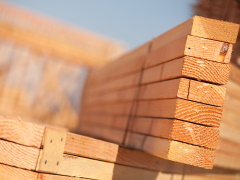Features
Constructing a natural environment
Date: 2021-02-26 09:44:20.0
Author: Jon Evans

Timber for construction.
Photo: Andy Dean Photography/
Shutterstock.
Natural materials, especially wood, have been used to construct buildings for thousands of years. Even today's brick-built houses often have wooden frames. But as revealed in a session at the annual meeting of the American Association for the Advancement of Science, which took place virtually in early February 2021, there is still much scope for expanding the use of nature in modern buildings. This is both in terms of building a wider range of structures using wood and employing a wider range of nature in buildings.
A wider range of structures generally means taller and larger structures, with the aim being proper wooden skyscrapers. At the moment, the tallest wooden structure is the 85m-tall Mjostarnet building in Norway, but this would be dwarfed by a planned 240m, 80-storey wooden building in Chicago. Such large wooden structures are possible because of engineered timber, in which thin sheets of wood are glued together. The grains in these sheets are often aligned so they either all run in the same direction or at right angles, producing materials with a strength per density that is higher than concrete and can almost reach that of steel.
By varying exactly how they’re made, various different engineered timbers can be produced for different applications. These include cross-laminated timber for roofs, walls and floors, and glued-laminated timber (glulam) for external, high-loading beams. Although engineered wood isn't quite as strong as steel, it doesn't need to be because it is much lighter, up to 80% lighter, which means it doesn't need to support as much weight. In addition, wooden buildings tend to be built in a different way to conventional tall buildings, with much of the weight supported by an external frame rather than a central column.
As well as not being quite as strong as steel, engineered timber is prone to things that don't affect steel, like moisture and infestation with fungi and insects, but can be protected with appropriate treatments. Various chemical and physical treatments can also influence other properties; for example, heat treatment can make timber stronger, but at the expense of making it more brittle.
More targeted modifications could also enhance the properties of timber. As Michael Ramage, head of the Centre for Natural Material Innovation at Cambridge University in the UK, said in his presentation, the hardest part of building with wood is connecting two pieces of wood together. But targeted modifications, such as impregnation, to the connecting sections could make this process easier.
The main advantage that timber has over steel and concrete as a building material is obviously that it is much greener. Whereas the production of steel and concrete produces a lot of greenhouse gases, timber actually locks up carbon for extended periods of time. According to Ramage, a 300m2, four-storey wooden building being constructed in Cambridge should lock up 540 tonnes of carbon dioxide.
Timber is thus poised to replace steel and concrete in the construction of more and more buildings, but that raises of the question of whether there will be enough timber to go around. Ramage doesn't see that being a problem at all. "We would be able to house the entire population of Europe using just about 25% of our sustainable harvest," he said.
As well as helping to construct new buildings, nature may also increasingly help to run them. Rachel Armstrong, professor of experimental architecture at Newcastle University in the UK, told the session about her research into employing communities of microbes to perform a whole range of functions within buildings, including generating power, cleaning water and treating waste. The idea would be to install banks of microbial fuel cells in blocks of flats, where microbes would generate power by breaking down organic waste.
Even in the middle of cities, we could soon be living much closer with nature.
The views represented here are solely those of the author and do not necessarily represent those of John Wiley and Sons, Ltd. or of the SCI.
Displaying 2 keywords used to tag this article:
- DG6582 Mens Moncler Down Jackets Gr
- Jules Audemars-Australia Best Quali
